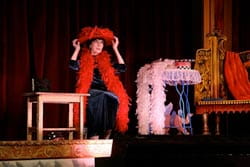 Three springs ago, I took a road trip to Death Valley, stayed at the Amorgosa Hotel and Opera House, and fell in love with Marta Becket.
Three springs ago, I took a road trip to Death Valley, stayed at the Amorgosa Hotel and Opera House, and fell in love with Marta Becket.
I never actually saw Marta, who is the opera house's founder, owner, and for forty-one years at that point, its sole performer. At the age of 84, she performed only Saturday nights. But I did fall in love with her story.
In the early 1960s Marta, a New York ballerina, singer, painter, and pianist on a road trip to California with her husband, stopped in Death Valley Junction with a flat tire. While their car was being fixed, she peeked through the window of a dilapidated dance hall, left over from mining days, and saw her future: her unlived life, her destiny. So she and her husband packed up and moved and rented the dance hall and opened the opera house.
The population of Death Valley Junction, which Marta now owns, was at one point two and even now is maybe ten. The first show was in February 1968. The audience would often be five or six people and if nobody came, as happened frequently, Marta danced anyway.In the middle of the desert, by herself, she danced anyway.
"I realized I'd moved to an area where art is completely unknown to most of the locals." So she gave dance lessons to the kids.
Then she got the idea to paint the walls of the opera house with an imaginary audience: nuns, courtiers, courtesans, popes, dukes. She spent four years painting the walls and two more painting the ceiling, during which time her husband, who was tending bar at a nearby brothel, got tired of playing second fiddle to Marta's art, found a girlfriend, and eventually left.
Armagosa, a documentary by Todd Robinson, was released in 2000. Someone asked, "You spent six years painting the walls of this place that could be sold, or torn down, any minute?"
"No one can take away the hours of joy I had painting it," Marta responded. "The experience is what's important. No one can take that from me."
Her husband left but she stayed: painting, playing the piano, sewing costumes, practicing, dancing, acting, singing, creating new shows: "Comeback Vaudeville," "Turkish Fairytale," "The Mirror, the Carpet and the Lemon." She appeared every Friday, Saturday, and Monday night without fail. The audiences slowly picked up. Busloads of folks came from Las Vegas, L.A., and in time, even farther afield. National Geographic did a special.
She danced for decades: through her broken heart, her mother's death, the floods that covered the floor of the opera house with mud. If you've ever been to Death Valley, you know that nerves of steel and an almost unearthly vision would be required to live in such eerie desolation. Just beautiful, but very harsh, very isolated. In summer the temperature can reach 125.
In later years Marta "discovered" the handyman Tom Willett, aka Wilget, who under different circumstances might be in danger of being called an eccentric and a clown, and incorporated him into her act. "He willingly put on a hoopskirt and picked up a fan in Gossip. His best turn was as Miss Victoria Hoops in Looking for Mr. Right." They were soul mates, this unlikely couple: the refined ballerina and the prankster who rode a golf cart around the property barking like a seal. They "took their meals" together and, Marta delicately gets across, went their separate ways to sleep.
They put on the show together for twenty-odd years and then one morning in 2005, Marta called, as she did every morning to wake him, and he was gone: felled by a stroke from which he died a few days later. She took one Saturday off and then she was back on stage. She painted Wilget into the circus backdrop of her next show.
She wrote a memoir: To Dance on Sands.
At 80, she was still dancing en pointe. She broke her hip in 2009 and went on to create what she called "The Sitting Down Show." She lives alone, in the back of the opera house, with a menagerie of stray cats, and still performs every Sunday night.
In this season of deserts, I can't help thinking that Marta's life, as it is for all of us, has been one long Lent. I can't help thinking of the three temptations of Christ (Mt. 4:1-11).
Man does not live by bread alone.
No one could accuse Marta of selling out or taking the shortcut. She gave everything she had, put out a huge gold-painted donation can, and continued to perform on whatever people chose to give back.
You shall not put the Lord, your God, to the test.
Her husband cheated but she didn't. She never risked compromising her work, nor betrayed the purity of her vision, by less than stand-up behavior.





